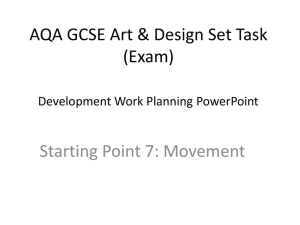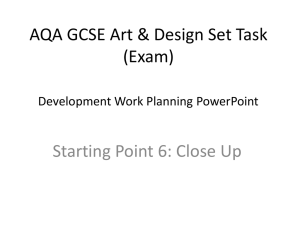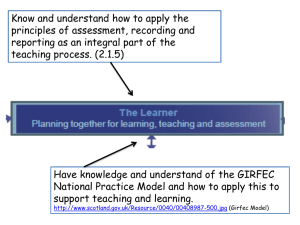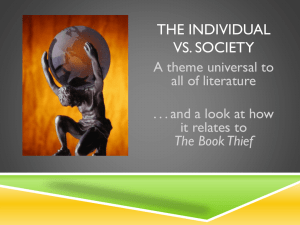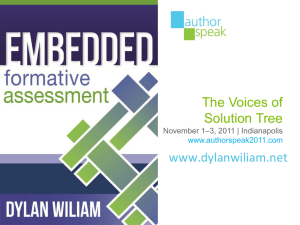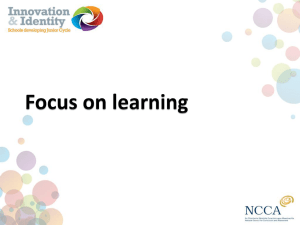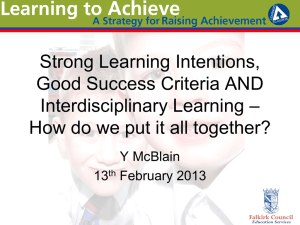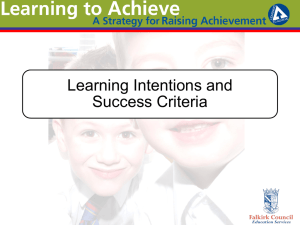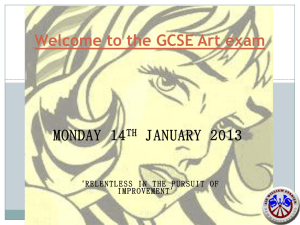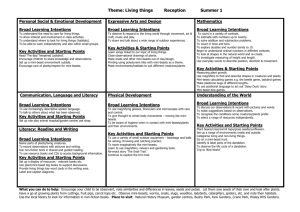File - Lordswood Boys` Art & Design Website
advertisement
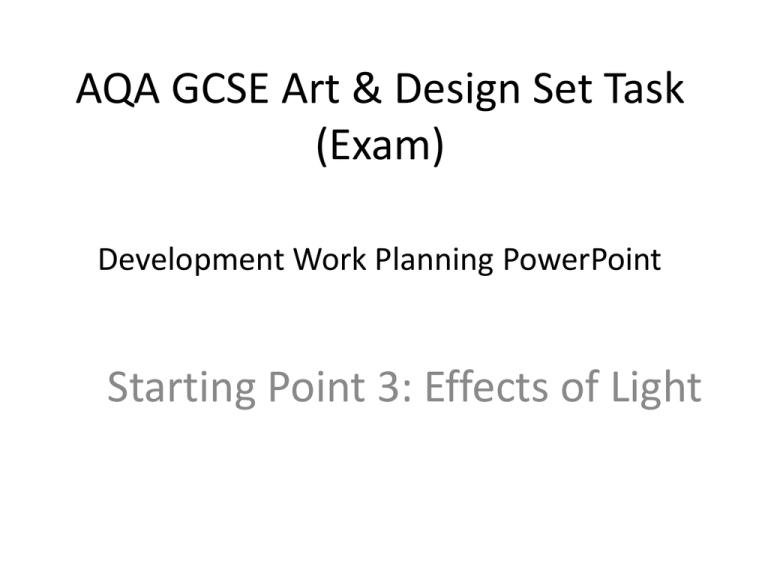
AQA GCSE Art & Design Set Task (Exam) Development Work Planning PowerPoint Starting Point 3: Effects of Light How to use this PowerPoint • Use this PP to plan and produce development work for your exam project. • You can always access it via the art website: www.lbsart.weebly.com • Green slides signal the start of a new stage in your planning or sketchbook Planning stages (green slides) (Tip: Use these stages as titles in your sketchbook to help planning) ( You may decide to do some stages in a different order) (Think about how long each stage will take and plan your time carefully) 1. 2. 3. 4. 5. 6. 7. 8. AO3 - Brainstorm the starting point AO1 – Artist and cultural investigations AO3 - Early intentions and ideas AO3 - Primary & Secondary recording AO1 – Investigations from other sources AO2 – Using materials to refine ideas AO4 – Final design AO4 – Final outcome (in 10 hour exam) Useful links • http://www.bbc.co.uk/schools/gcsebitesize/ar t/ • http://collectives.tate.org.uk/ • http://www.tate.org.uk/art 1. AO3 - Brainstorm the starting point EFFECTS OF LIGHT Impressionist painters were inspired by how the effects of light changed the appearance of their subjects. More recently, artists Susan Derges and Garry Fabian Miller have exploited the effects of light to create camera-less photographs, and filmmaker Tacita Dean has explored the unique effects of projected light. Research appropriate sources and create your own work in response to Effects of Light Produce a brainstorm for the theme that uses word association to generate ideas. Use the images on the next slide to inspire you... (GRADE A / A*) A highly developed ability to fluently and skilfully record ideas and insights relevant to intentions (GRADE B) A consistent ability to skilfully record ideas and insights relevant to intentions (GRADE C) A generally consistent ability to effectively record ideas and insights relevant to intentions Examples of brainstorms.. . 2. AO1 - Artist investigations • • • Investigate and analyse at least 2 of the artists given in the exam starting points. Use reliable internet sources and if possible books and other sources Use quality images, drawings and annotations using the 4 headings (GRADE A / A*) A confident and highly developed ability to demonstrate analytical and cultural understanding (GRADE B) A consistent ability to demonstrate analytical and cultural understanding (GRADE C) A generally consistent ability to demonstrate analytical and cultural understanding TOP TIP: Take care with presentation and the spelling, punctuation and grammar of written work. Use the annotation help sheets to extend your vocabulary Lisa Milroy • www.lisamilroy.net Lisa Milroy is a Anglo-Canadian painter who lives and works in the UK. Lisa Milroy was born in 1959 and raised in Vancouver, Canada. She moved to London in 1979 to study at Goldsmiths College Lisa Milroy Shoes 1985 Impressionism Taking their name from Claude Monet's 'Impression, Sunrise', the Impressionists were established in Paris during the 1870's. A diverse group of painters, rejected by the art establishment, defiantly set up their own exhibition. They included Monet, Renoir, Pissarro and Degas. Landscapes, and scenes from modern urban and suburban life painted in bright, pure colours are typical. Impressionists often began (and sometimes completed) their paintings outdoors rather in a studio. Their rapidly applied brushstrokes are often visible. Claude Monet, The Water-Lily Pond, 1899 click here for a useful link! Impressionsim Renoir, The Skiff (La Yole), 1875 Renoir, At the Theatre (La Première Sortie), 1876-7 Susan Derges • http://www.susanderges.com/ Camera-less photography click here for a useful video! Tacita Dean • http://www.bbc.co.uk /news/entertainmentarts-15243030 • http://www.frithstreet gallery.com/artists/bio /tacita_dean/?/dean.h tml 3. AO3 - Early intentions and ideas -Choose an area of your brainstorm to focus on - Make written notes about your early intentions for the project and what you hope to achieve by the end. (This plan may change!) - Use the 4 headings and also include: -Objects you want to record visually -Artists and other sources you want to investigate CLOSE -UP TOP TIP: You could include some small thumbnail drawings to show your idea visually Content Process Meaning Purpose 4. AO3 - Primary and Secondary Recording You must now find appropriate objects and items to record from. The main ways you will do this will be through observational drawing and photography. Record from primary sources first and move onto secondary sources if necessary… (GRADE A / A*) A highly developed ability to fluently and skilfully record observations relevant to intentions (GRADE B) A consistent ability to skilfully record observations relevant to intentions (GRADE C) A generally consistent ability to effectively record observations relevant to intentions Observational drawing Success Criteria: -Quality tonal shading -High contrast - Interesting and unusual compositions - Zooming in and cropping -Dramatic lighting Photography Success Criteria: -Interesting and unusual compositions -Appropriate themes - Zooming in and cropping - dramatic lighting 5. AO1 - Investigations from other sources • You must extend your investigations by using other sources of information • This could include other artists, a visit to a gallery or a local place of interest related to your theme • Record your investigations using photography, drawings, collected items and written notes. TOP TIP: Always refer to your intentions, state why you have investigated a source, how will it help with your final piece? 6. AO2 - Using materials to refine ideas (GRADE A / A*) A highly developed ability to thoughtfully refine ideas through purposeful and discriminating selection of appropriate materials and techniques (GRADE B) A consistent ability to thoughtfully refine ideas through purposeful selection of appropriate materials and techniques (GRADE C) A generally consistent ability to effectively refine ideas through experimenting and selecting appropriate materials and techniques • • • Choose appropriate materials to develop your ideas See the next slide for ideas about materials Re-visit and refine your experimental pieces up to the highest standard possible. TOP TIP: Use materials that you have used before and are confident with! Never spend more time writing about your practical work than doing it! Using materials The list below shows what you should have covered in your GCSE Art Remember to use materials that you are confident with already... 2D Pencil Fineliner / Pen Watercolours Acrylic Paints Collage Polystyrene Printing Lino Printing http://www.bbc.co.uk/schools/gcsebitesize/art /video/ 3D Card Relief Wire / card sculpture Clay slab Clay coil / pinch pot Glazing techniques TOP TIP: The link below takes you to GCSE Bitesize and useful practical videos for 2D and 3D techniques 7. AO4 – Final Design • Produce a quality final design for your final piece • This should be a refined drawing of how your 2D / 3D piece will look • Make notes using the 4 headings TOP TIPS: Highlight how your final piece will realise your intentions (GRADE A / A*) A highly developed ability to present an imaginative, personal, informed and meaningful response when realising intentions. (GRADE B) A consistent ability to present an personal, informed and meaningful response when realising intentions. (GRADE C) A generally consistent ability to effectively present an personal, informed and meaningful response when realising intentions. Highlight links and connections to artist work that you have looked at.. Final Design CONTENT PROCESS MEANING PURPOSE
